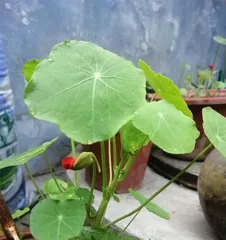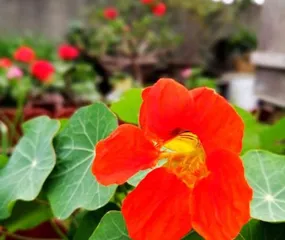Nasturtium is a plant with high ornamental value, and its full bloom can fill the entire room with vitality and energy. However, for those living in cities without a garden, the task of growing flowers can seem a bit tricky. Would you also like to try growing a pot of nasturtiums at home? This article will start from the characteristics and care methods of nasturtiums to introduce to you in detail whether nasturtiums are suitable for indoor cultivation.

Characteristics of Nasturtiums
Nasturtiums are native to South America and are an annual herbaceous plant with pinnate compound leaves. Flowers grow in clusters at the tips of the branches, with various and brilliant colors. Nasturtiums have high requirements for a sunny environment and typically bloom in summer and autumn.
Are nasturtiums suitable for indoor cultivation?
Nasturtiums are sun-loving plants and need sufficient sunlight to grow normally. However, if your home lacks sufficient sunlight, you can also provide auxiliary light for the nasturtiums, such as using LED plant lights. In addition, nasturtiums have requirements for temperature and humidity and are suitable for growing in a warm and humid environment. When growing nasturtiums indoors, it is necessary to pay attention to maintaining air humidity and ventilation.

Selecting Nasturtiums
When selecting nasturtiums, you should choose healthy plants with full leaves and unopened flower buds. It is best to choose darker varieties because darker leaves can absorb more light, which is beneficial for the growth of the plant.
Suitable Soil
Nasturtiums are suitable for growing in well-draining soil because excessive water can lead to root rot. You can add a moderate amount of organic fertilizer to the soil, which is beneficial for the growth and flowering of the plant.
Watering and Fertilizing
Nasturtiums need frequent watering, but avoid overwatering to prevent root rot. Usually, watering once a week is sufficient. In terms of fertilizing, nasturtiums need regular fertilization to ensure the normal growth and flowering of the plant.

Pruning and Placement
During the growth process, nasturtiums require moderate pruning, which helps maintain the health and shape of the plant. When placing the plant, you should choose a location with sufficient sunlight and pay attention to ventilation and air humidity.
Pest and Disease Control
Nasturtiums are susceptible to aphids and powdery mildew. When pests or diseases are found, timely measures should be taken for prevention and control, and pesticides or medications can be used to eliminate them.
Precautions
When growing nasturtiums indoors, it is important to maintain suitable temperature and humidity and regularly inspect the plant to prevent pest and disease infestations. In addition, when placing the plant, avoid direct exposure to air conditioning or heating vents.
Advantages
Nasturtiums have high ornamental value and can add greenery and vitality to your home. They are also relatively easy to care for and suitable for beginners without much care experience.
Disadvantages
Nasturtiums require plenty of sunlight and humidity and are not suitable for growing in environments that are too cold. At the same time, nasturtiums are susceptible to pests and diseases during their growth and require timely control measures.
Precautions
When caring for nasturtiums, it is particularly important to maintain suitable temperature and humidity and conduct regular inspections and cleaning. In addition, prune the plant in a timely manner to maintain its shape and health.
Common Questions
Common questions include: Why aren't my nasturtiums flowering? How do I fertilize nasturtiums? How do I control powdery mildew on nasturtiums? For these questions, we provide detailed answers and solutions.
Practical Tips
When caring for nasturtiums, we can use some practical tips to improve the growth quality of the plant. For example, when watering, you can choose to use a sprinkling method, which is beneficial for the growth and development of the root system. At the same time, you can water the plant in the morning or evening, which can reduce evaporation and waste.
Experience Sharing
When caring for nasturtiums, we can learn from the experiences and sharing of others to improve the effectiveness of care. For example, when choosing a variety of nasturtium, you can choose varieties with a higher growth rate and flowering volume.
Through the introduction of the characteristics and care methods of nasturtiums, we can draw the conclusion that nasturtiums are suitable for indoor cultivation. As long as you pay attention to maintaining suitable temperature, humidity, and light conditions, and regularly prune and control pests and diseases, you can get your nasturtiums to bloom at home and create a beautiful garden.